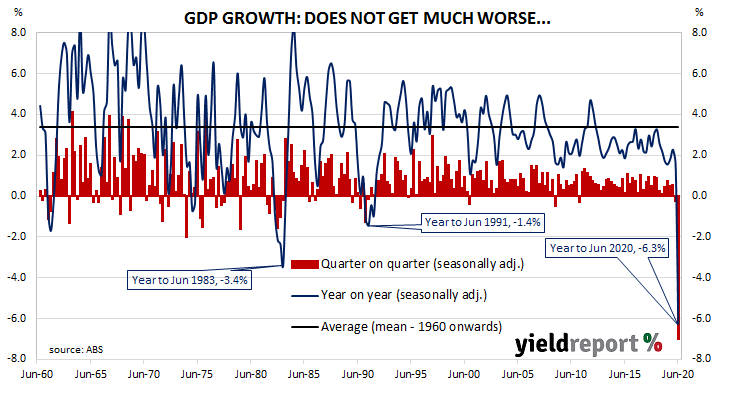Summary: GDP down 7.0% in June quarter; worse than expected; “the sharpest quarterly decline” since data series began in 1959; increased government spending, fewer imports soften massive fall in household consumption; report unlikely to postpone tapering of federal stimulus measures; focus turns to effects of Victorian shutdown, lower fiscal stimulus on Q3, Q4 GDP.
Since the “recession we had to have” as the recession of 1990/91 became known, Australia’s GDP growth has been consistently positive, with only the odd negative quarter here and there. Australia even managed to avoid two consecutive quarters of negative growth in the GFC period. However, Australia’s first recession in nearly thirty years was inevitable once governments introduced restrictions which shut businesses and limited people’s movements for an extended period of time.
Figures released by the ABS indicate GDP contracted by 7.0% over the June quarter. It was a worse result than the 6.0% drop which had been generally expected and it was a massive deterioration from the March quarter’s -0.3%. On an annual basis, GDP decreased by 6.3%, down from the March quarter’s comparable figure of 1.6%.
Westpac senior economist Andrew Hanlan said the quarter represented “the sharpest quarterly decline” since the ABS series began in 1959, “the previous low a 2.0% [fall] in June 1974.” He said the services sector had been hit hardest.

Longer-term Commonwealth bond yields fell broadly in line with movements of their US Treasury counterparts in overnight trading. By the end of the day, 10-year and 20-year Treasury bond yield had each lost 4bps to 0.95% and 1.53% respectively. The 3-year yield remained unchanged at 0.31%, 6bps above the RBA’s target rate.
In the cash futures market, expectations of a change in the actual cash rate, currently at 0.13%, continued to remain low. By the end of the day, contracts implied the cash rate would remain in a range of 0.115% to 0.120% through to the end of 2021.
Morgan Stanley Australia equity strategist Chris Read said the result is unlikely to change the Federal Government’s plan to reduce its various assistance packages, “While the decline in activity in the quarter is undoubtedly severe, we don’t see anything in the detail of this report that would dissuade the Government from tapering its stimulus measures from Q4, or significantly shift its policy plan for the Federal Budget on October 6.”

